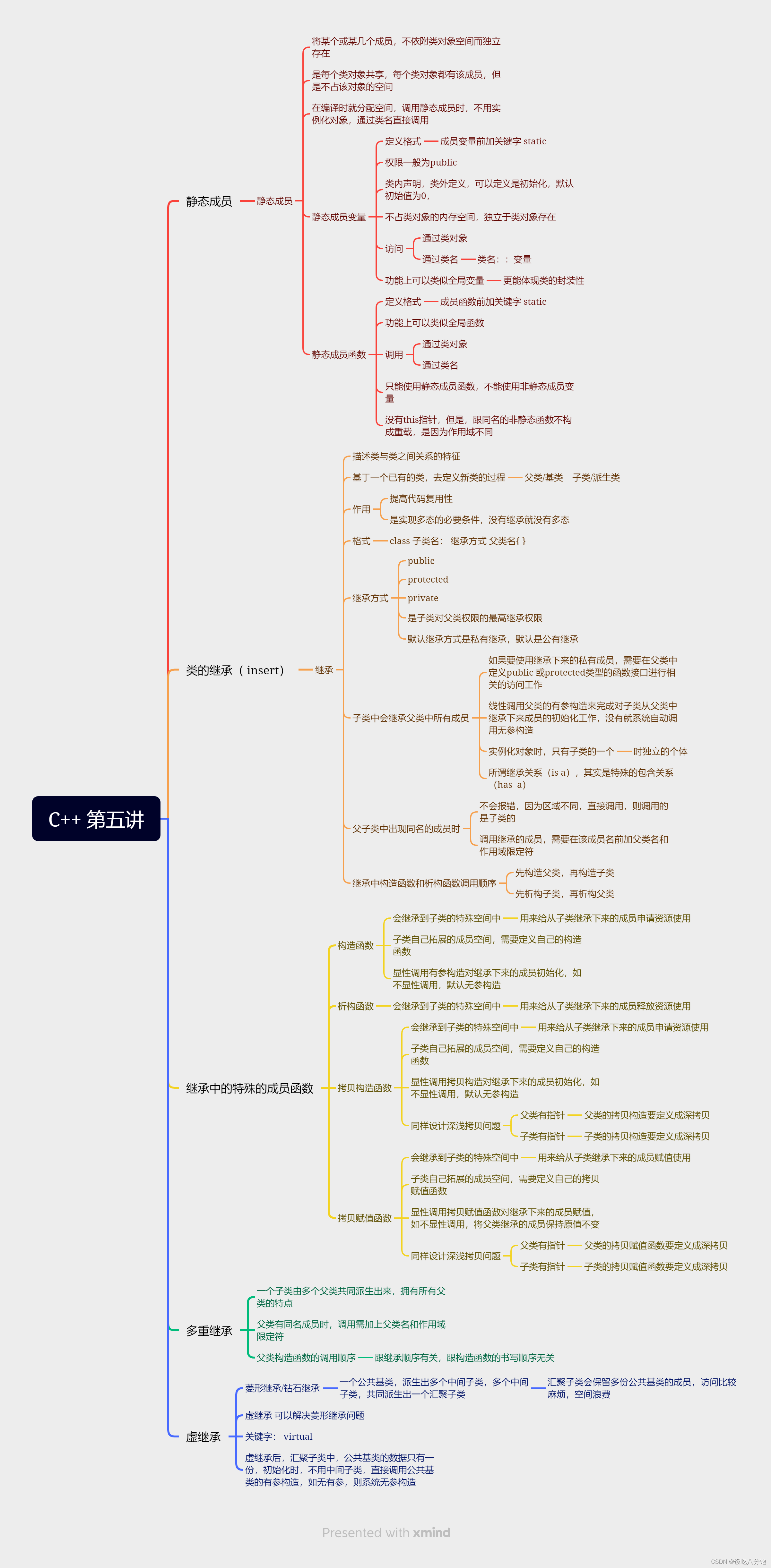思维导图


模板类实现顺序栈
主函数
#include "test.h"
int main()
{
Stack <DATATYPE>s; // <int>/<string>/<char>
char ch = 0;
DATATYPE e = 0; // int / string / char
//入栈
do{
if(true == s.my_full()){
break ;
}
cout << "入栈,请输入要入栈的数据 >>>" << endl;
cin >> e;
s.my_push (e);
cout << "是否继续入栈 Y/N" <<endl;
cin >> ch ;
}while('Y' == ch || 'y' == ch);
s.my_top();
s.my_size();
s.show();
//出栈
do{
cout << "出栈的数据是 >>>" << s.my_pop()<< endl;
if(true == s.my_empty()){
break;
}
cout << "是否继续出栈 Y/N" <<endl;
cin >> ch ;
}while('Y' == ch || 'y' == ch);
s.my_top();
s.my_size();
s.show();
Stack <DATATYPE>s1;
s1 = s;
s1.show();
return 0;
}
头文件
#ifndef TEST_H
#define TEST_H
#include <iostream>
#define MAXSIZE 10 //栈 大小
#define DATATYPE char //数据类型
using namespace std;
template<class T>
class Stack
{
protected:
int top;
T *ptr;
public:
//无参构造
Stack():ptr(new T [MAXSIZE-1]),top(-1) {
cout << "创建栈" << endl;
}
//拷贝赋值函数
Stack &operator =(const Stack &other);
//访问栈顶元素
T &my_top();
//判空
bool my_empty();
//判满
bool my_full();
//返回容纳的元素个数
int my_size();
//入栈
//void my_push( char &data);
void my_push( T &data);
//出栈
T my_pop();
//输出
void show(){
int i = 0;
for(; i <= top; i++){
cout << ptr[i] << " ";
}
cout << endl;
}
};
//拷贝赋值函数
template<class T>
Stack<T> &Stack<T>::operator =(const Stack &other){
cout << "拷贝赋值函数" << endl;
this->top = other.top;
delete []ptr;
this->ptr = new T ;
int i = 0;
for( ;i <= top; i++){
ptr[i] = other.ptr[i];
}
return *this;
}
//判空
template<class T>
bool Stack<T>::my_empty(){
if(top == -1){
cout << ">>> 栈空 <<<" << endl;
return true;
}else{
return false;
}
}
//判满
template<class T>
bool Stack<T>::my_full(){
if(MAXSIZE -1 == top){
cout << ">>> 栈满 <<<" << endl;
return true;
}
return false;
}
//返回容纳的元素个数
template<class T>
int Stack<T>::my_size(){
cout << "元素个数 >>> " << top+1 <<endl;
return top+1;
}
//入栈
template<class T>
void Stack<T>::my_push(T &data){
ptr[++top] = data;
}
//出栈
template<class T>
T Stack<T>::my_pop(){
return ptr[top--];
}
//访问栈顶元素
template<class T>
T &Stack<T>::my_top(){
cout<< "栈顶元素 >>> " << ptr[top]<< endl;
return ptr[top];
}
#endif // TEST_H
模板类实现循环队列
#include <iostream>
using namespace std;
#define MAXSIZE 10
#define DATATYPE int
template<class T>
class Queue
{
protected:
int rear;
int front;
T *data;
public:
//无参构造
Queue();
//析构函数
~Queue();
//拷贝赋值函数
Queue &operator=(const Queue &other);
//访问第一个元素
T my_front();
//访问最后一个元素
T my_rear();
//判空
bool my_empty();
//判满
bool my_full();
//插入
void my_push(T &e);
//删除
T my_pop();
//元素个数
int my_size();
//输出
void show();
};
int main()
{
Queue <DATATYPE>q;
//入队
DATATYPE e;
char ch = 0;
do{
if(true == q.my_full()){
break ;
}
cout << "入队,请输入要入队的数据 >>> " ;
cin >> e;
q.my_push (e);
cout << "是否继续入队 Y/N >>> ";
cin >> ch ;
}while('Y' == ch || 'y' == ch);
q.my_size();
q.show();
//出栈
do{
cout << "出队的数据是 >>> " << q.my_pop() << endl ;
if(true == q.my_empty()){
break;
}
cout << "是否继续出队 Y/N >>> " ;
cin >> ch ;
}while('Y' == ch || 'y' == ch);
q.my_size();
q.show();
Queue <DATATYPE>q1;
q1 = q;
q1.show();
q1.my_size();
q1.my_front();
q1.my_rear();
return 0;
}
template<class T>
Queue<T>::Queue():
rear(0),
front(0),
data(new T[MAXSIZE]) {
cout << "无参构造" <<endl;
}
template<class T>
Queue<T>::~Queue(){
delete [] data;
cout << "析构函数" <<endl;
}
//拷贝赋值函数
template<class T>
Queue<T> &Queue<T>::operator=(const Queue &other){
cout << "拷贝赋值" << endl;
if(this != &other){
delete [] data;
this->data = new T[MAXSIZE]{*(other.data)};
this->rear = other.rear;
this->front = other.front;
int i = 0;
for(i = front; i!= rear; i=(i+1)%MAXSIZE){
data[i] = other.data[i];
}
}
return *this;
}
//访问第一个元素
template<class T>
T Queue<T>::my_front(){
cout << "第一个元素为 >>> " << data[front] << endl;
return data[front];
}
//访问最后一个元素
template<class T>
T Queue<T>::my_rear(){
cout << "最后一个元素为 >>> " << data[rear-1] << endl;
return data[rear-1];
}
//判空
template<class T>
bool Queue<T>::my_empty(){
if(rear == front){
cout << "队空" << endl;
return true;
}
return false;
}
//判满
template<class T>
bool Queue<T>::my_full(){
if(front == (rear+1)%MAXSIZE){
cout << "队满" << endl;
return true;
}
return false;
}
//尾插
template<class T>
void Queue<T>::my_push(T &e){
data[rear++] = e;
}
//头删
template<class T>
T Queue<T>::my_pop(){
return data[front++];
}
//元素个数
template<class T>
int Queue<T>::my_size(){
return (MAXSIZE - front + rear)%MAXSIZE;
}
//输出
template<class T>
void Queue<T>::show(){
int i = 0;
for(i = front; i!= rear; i=(i+1)%MAXSIZE){
cout<< data[i] << " " ;
}
cout << endl;
}